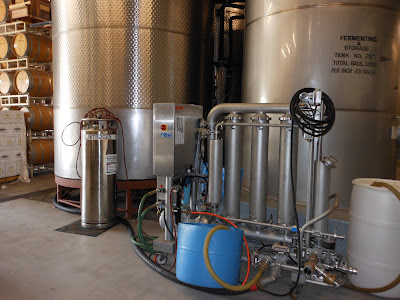We don't often visit wineries that bottle about 500,000 cases a year and ship all over the world. Boutique this isn't! But it's L.A.'s only winery and a historical landmark with deep roots. Established in 1917 by Italian immigrant Santo Cambianica, whose nephew Stefano Riboli later joined him in the business, San Antonio has stayed in the family through multiple expansions and modernizations. For a long time the Ribolis specialized in sweet wines; they still do an astonishingly brisk business in the Stella Rosa brand, which they import from Italy. Also of note: they're the largest wine supplier to the U.S. Catholic church.
 |
| Almost there! |
 |
| Steel fermentation tanks |
 |
| Chardonnay lees |
 |
| Bottling machinery |
Visitors to San Antonio are invited to taste three wines at no charge or to try an “artisan series tasting” for $10. We chose the latter, and especially liked the 2007 Paso Robles Pretty Penny Vineyard Estate Syrah. Complementary tours take place Monday-Friday at noon, 1:00, and 2:00 and weekends between 11:00 and 4:00, on the hour. The winery sells a diverse selection of wine, beer, and spirits from around the world. There is a restaurant serving lunch and dinner (last seatings are at 6:15, 7:00 on weekends) as well as three dining rooms that can be reserved for private events.
 |
| Store and tasting room |
737 Lamar St., Los Angeles
Open daily
323.221.7261



















